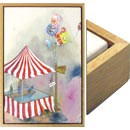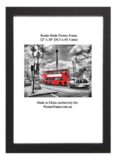Before you rush out buying floater frames just because all you friends seem to be doing so, please do read this post which endeavours to explain what  these newly-discovered picture frames are. The floater frame evolved from the 1950's picture framing "stripping" style. This style was an attempt to embellish and visually seal, or finish, the appearance of unframed oil paintings on canvas. This involved the fixing of thin wood strips or plywood trims, about 3 to 5mm thick, to the four, external sides of a stretcher frame. However, while this style of picture framing also known as 'Baguette" improved the appearance of the oil painting's sides, it did not strengthen the stretcher frame construction and provid no support for any future wall hanging.
these newly-discovered picture frames are. The floater frame evolved from the 1950's picture framing "stripping" style. This style was an attempt to embellish and visually seal, or finish, the appearance of unframed oil paintings on canvas. This involved the fixing of thin wood strips or plywood trims, about 3 to 5mm thick, to the four, external sides of a stretcher frame. However, while this style of picture framing also known as 'Baguette" improved the appearance of the oil painting's sides, it did not strengthen the stretcher frame construction and provid no support for any future wall hanging.
The modern, standard float frame is basically an evolved baguette and has become popular since early 2000's. Its profile is in the L-shape with the back of the moulding being the base which supports the stretcher frame.
A floater frame is nearly always cut 10 or 20 mm larger than the actual stretcher framer. Once the stretcher frame is placed inside the floater frame it will look as though it "floats" inside the floater because it is smaller. Floater frames come in varying styles, shapes, sizes and colours. They may be short-based, long-based, standard-floated or step-floated, to name just a few variations.

The diagram above shows the self-evident, structural and cosmetic advantage a floater frame has over a baguette. In the main, the floater frame is much stronger and more cosmetically appealing. It is fixed or attached to the back of a stretcher frame rather than its sides.
There are also other float frame variations such as the back float frame, the stacked float frame and the stacked back float frame which however are uncommon and more specialized. While the floater frame is quite appealing it has a distinct disadvantage, it costs twice than the average frame and this is because any canvas or artwork to be float-frame will need not one but two frames, i.e., a stretcher frame and a floater frame.
Just by way of exercise, we'd charge $92 to stretch-frame a 60x90cms oil on canvas. That's one frame. Then if a floater frame is needed, we'd probably charge another $148 or so. That's two frames, totaling $240 for a "different" look. Some customers will pay but most won't, at least that's what we find at the coalface, so to speak. They ask us why a floater frame is so "expensive" and we have to tell them that's because two frames need to be built, not just one, and the picture framing work is double.
On the other hand, there are a few avant-garde picture framers who work, or rather, practise in niche markets. These specialists think outside the square and design new floater picture frame designs purposely to stay ahead of their competition with their new design ideas. They cater to a rather narrow, elite clientele who can and will pay what most customers can't or won't. That said, the floating frame's look and appeal is quite distinctive, and, when seen on a wall, it spells "class".
For ordinary custom frames and custom picture framing ( without a floater frame ) consider ordering you a custom-made, Frame Kit.









I know that picture-framer made floater frames look really nice but they’re sooo expensive! I had a pair of 48×36" oil paintings that I had stretch-framed and nearly died of a heart attack when I went around to get quotes. The cheapest quote I got was for $295 ea. if I paid in by BSB. On quote I got in Richmond was for $565 each !! I thought to myself this is an absolutely crazy price to pay for someone to put 8 sticks of thin wood around my frames! So my husband and I went to Bunnings, got about $46 worth of wood, about $22 worth of paint and spent a Sunday making our own floater frames. Granted, if you look at them real close you’ll see that they’re not as flash as those by a professional picture framer, but hey, we saved hundreds !! Besides no-one of our friends noticed and they all thought our frames were custom-made floater frames!
I absolutely disagree that floater frames are expensive! They are absolutely worth every dollar spent on them when constructed for only that elegant, classy and modern artwork which you know suits your home. I bought and had made, four large, stunning, modern oils on canvas, stretch-framed in Italian floater frames which made my new home, open plan living-entertainment absolutely breathtaking! To me it’s money well spent!
Yes, floater frames are indeed expensive because, in effect, these are double picture frames, one internal, the other external. But the finished look is sleek, polished, modern and simply elegant, Like everything in life, you get what you pay for. We have top-of-the-line clothes and furniture, so why not floater picture frames? I guess you can either afford it, or not.